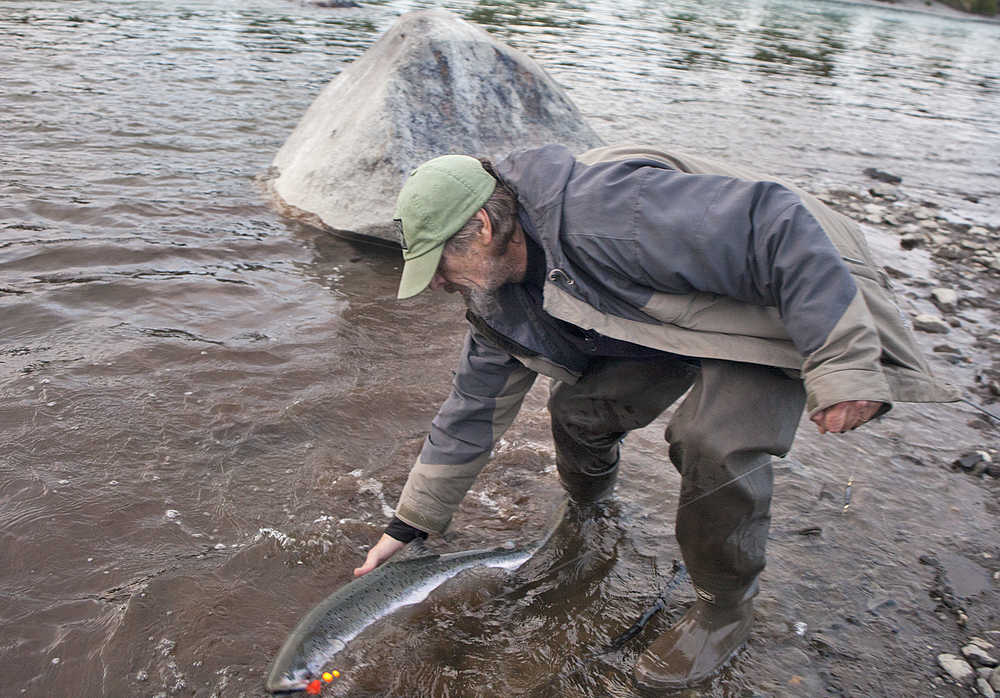Editor’s note: This article has been corrected to clarify the stocking numbers. The Alaska Department of Fish & Game increased the smolts stocked in Crooked Creek from 105,000 to 140,500 in 2014, and the updated number is a continuation of that stocking amount. They also plan to hold, imprint, artificially spawn and release 101 male and 101 female natural- and hatchery-produced king salmon at the Crooked Creek Facility.
The Alaska Department of Fish and Game wants 3,000 king salmon to call Crooked Creek home.
The Kasilof River/Crooked Creek Chinook Salmon Enhancement plan, updated in the annual Statewide Stocking Plan, plans to continue stocking 140,500 king salmon smolt into Crooked Creek, a tributary of the Kasilof River.
The goal is a return of approximately 3,000 fish. This would be double the current return, which clocked in at 1,459 fish in 2015, according to Fish and Game records. The Division of Sport Fish estimates will generate about 17,500 angler days each year, making it about 3 percent of all the angler days fished in Kenai Peninsula freshwater.
The department would maintain its current escapement goal of between 650 and 1,700 naturally-produced adult king salmon that would spawn upriver of the Crooked Creek facility.
The Kasilof has a historical king salmon run, but it is significantly smaller and later in the year than the Kenai River’s king salmon run. Some of the fish harvested in the terminal fishery at the mouth of the Kasilof River are headed for the Kenai River terminus, but the majority harvested there are headed for the main stem of the Kasilof River.
Gradually, the number of naturally produced fish declined as the hatchery production increased in the 1980s, but the natural population has remained above 50 percent since 2002.
The Department Fish and Game has been working on projects to enhance the kings in the Kasilof River and Crooked Creek for several years. The plan is updated every year — the department increased the smolts from 105,000 to 140,500 in 2014, and the number in the plan is a continuation of that quota, said Andrew Garry, the stocking coordinator for the William Jack Hernandez State Hatchery.
“The intent of the hatchery enhancement is certainly to reduce pressure on wild stocks, and to create a more diverse experience,” Garry said. “(The Crooked Creek project) is a sport fish goal.”
The first fish would be held, imprinted, artificially spawned and released from the Crooked Creek Facility in June 2016. Fish and Game biologists would capture 101 male and 101 female fish that return to Crooked Creek in July 2016. Only naturally produced salmon would be released into Crooked Creek; hatchery-produced fish would be released at other terminal fisheries.
The statewide stocking plan also includes a king salmon enhancement project in the Ninilchik River. The run on the Ninilchik River has decreased drastically in the past few years, falling from an average harvest of 1,433 salmon from 1999-2007 to 319 from 2008-2013. Fish and Game plans to continue the stocking program in the Ninilchik, releasing 150,000 thermally marked smolts in the river, which are all tagged with code wires and have their adipose fin clipped.
Although the stocking program includes all types of fish native to Alaska, the Kasilof, Kenai and Ninilchik rivers are largely king salmon rivers, Garry said. The department does work on coho fisheries in Seward and along the Homer Spit, he said.
“King enhancement is certainly a priority for us, but we certainly make a concerted effort to enhance the coho fisheries as well,” Garry said. “It just happens that we aren’t working on the coho in those rivers.”
Statewide, king stocking is a much larger program than coho. Approximately 1.2 million coho smolt are stocked every year, while about 4 million king salmon smolt go out every year, Garry said. The survival rate in the oceans is about the same for the two species, he said.
The statewide stocking plan is open for public comment until Jan. 29. Comments can be submitted by email to andrew.garry@alaska.gov or mailed to Andrew Garry at William Jack Hernandez Sport Fish Hatchery, 941 N. Reeve Blvd., Anchorage, AK, 99501.
Reach Elizabeth Earl at elizabeth.earl@peninsulaclarion.com.

